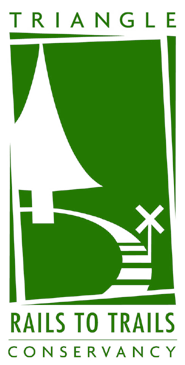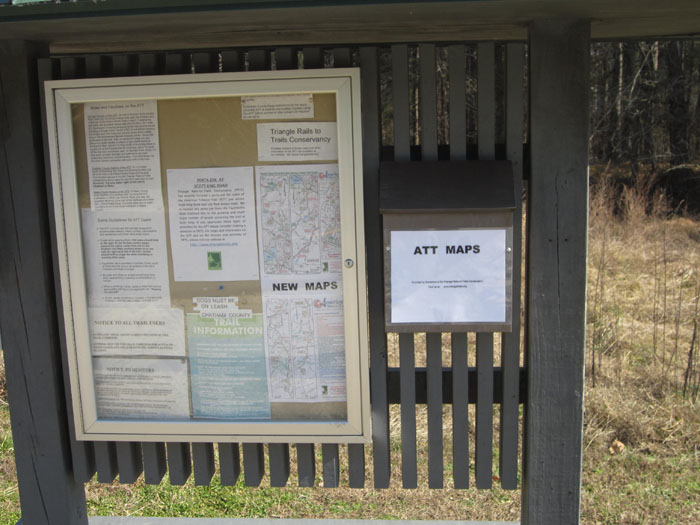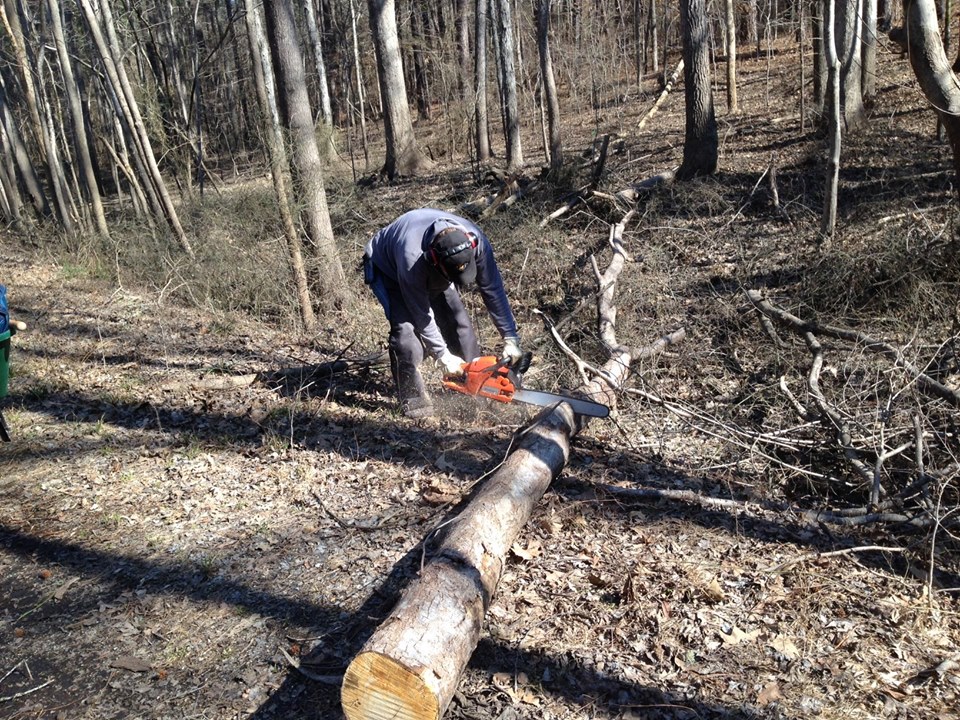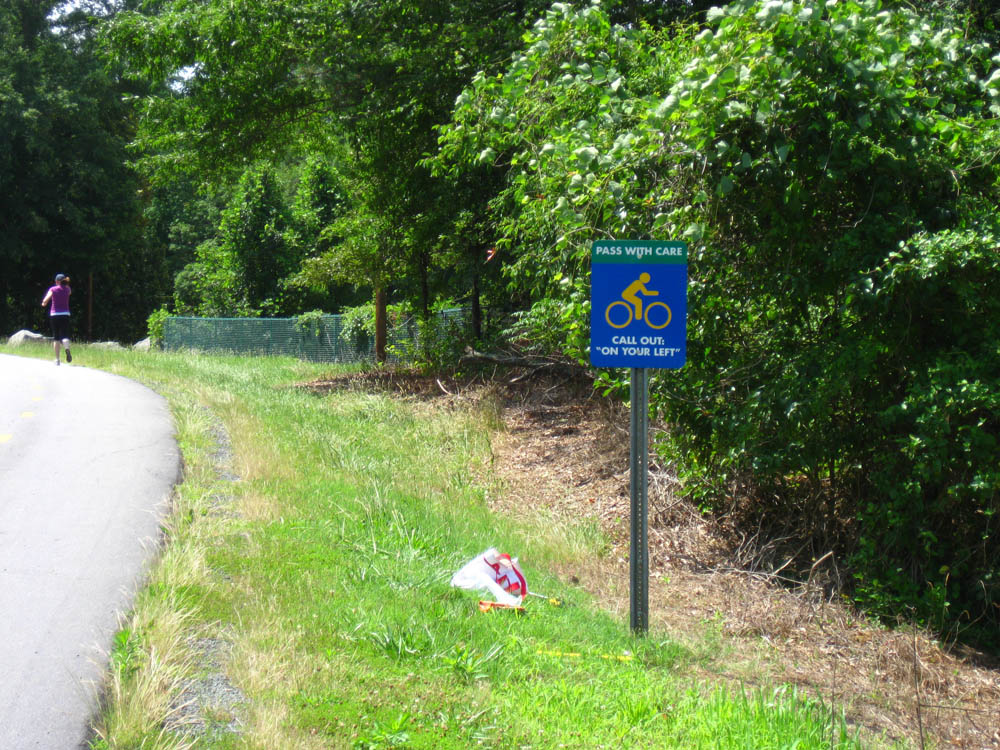(Adapted from article written by Al Capehart in 1993)
The American Tobacco Trail (ATT) is a 22-mile-long rails-to-trails project located in the Research Triangle region of North Carolina. The route crosses through the City of Durham; Durham, Chatham, and Wake counties; the planning jurisdictions of the Towns of Cary and Apex; and passes through the Jordan Lake project lands of the U.S. Army Corps of Engineers.
The former railroad corridor on which the American Tobacco Trail is being built was originally developed as the New Hope Valley Railroad. This later became the Durham and South Carolina Railroad.
The Durham and South Carolina RR (D&SC) began construction in the New Hope valley in September of 1905 and was completed in October 1906. The line followed the New Hope River basin passing the communities of Seaforth, Farrington and others, until it joined the Durham and Southern RR, and again the Seaboard Air Line RR, in East Durham, using their track to reach downtown Durham. In 1920, Norfolk Southern penned a 99-year lease with the D&SC RR, and in 1957 they bought the small railroad outright.
In April 1969, the U.S. Army Corps of Engineers entered into a relocation agreement with the D&SC, with Norfolk Southern as a third party, to move the rail line from the New Hope River basin to higher ground in preparation for the building of the New Hope Dam and Reservoir, later known as Jordan Lake. The Corps spent about $250,000 to negotiate and acquire the land for the rail line and then $4,900,000 to construct the 18.5-mile railroad. The new line branched off the old one about 1000 feet south of what is now I-40 at a place called Penny, and rejoined it near Bonsal in Wake County. The line was improved with 100-pound steel rails, replacing the 70 pound steel rails used on the old line built by the Durham and South Carolina railroad. In March 1974, the transfer took place with the D&SC and Norfolk Southern getting the new steel and fee simple property from the U.S. Army Corps of Engineers. However, earlier that year, the Southern Railway and the Norfolk Southern had merged, making the D&SC line redundant. It was decided to abandon the line. The Southern Railway would later merge in 1982 with the Norfolk & Western, forming today’s Norfolk Southern Corporation.
The relocation agreement stated that before the transfer, three trains had to run over the new line to test its stability. The story goes that as the third train backed up the route, it took up the steel and ties for their salvage value. An adjacent property owner accounted that he saw only one train, which carried pulpwood – but not tobacco – ever use the corridor. Formal abandonment began in 1979. The tracks, ties, and gravel were removed in 1983, leaving a long “dirt road” that was used informally as both a recreational trail and dumping ground for area residents.
Until 1995, the majority of the railroad corridor remained under Norfolk Southern ownership, although several sections of the corridor were acquired by other business or private entities. Carolina Power and Light, now Progress Energy, had begun construction of its Shearon Harris Nuclear Power Plant directly on the DS&C railroad property, and acquired the 12 miles of rail corridor from the plant to Duncan. The NC Dept of Transportation now did not have to build an expensive railroad bridges over US Route 1 nor soon to be constructed I-40.
Also, in Durham, the developers of Woodcroft acquired the railroad property at its intersection with Woodcroft Parkway with plans for commercial development. The developer of Folkstone acquired half of the RR corridor in 1982 for $1,800 and sold it to the City of Durham for part of its Greenway in 1992 for $28,000. Some of the adjacent property owners in Wake County were able to buy back from Norfolk Southern the property they or earlier owners originally sold to the Corps. The Town of Cary purchased just over a mile of the corridor to carry their water line from Jordan Lake to their filtration plant. The East Carolina Chapter of the National Railway Historical Society purchased six and a half miles of the line from the Durham and South Carolina RR in 1983 and now operates the New Hope Valley Railway, a hobby railroad, and the N.C. Railroad Museum. Between 1995 and 1998, the remaining sections of the railroad corridor (in southern Durham, Chatham, and Wake Counties) were purchased by the NC Department of Transportation.
In April 1987, the Durham City Council, at the encouragement of the Durham Urban Trails and Greenways Commission, passed a resolution stating that all abandoned rail corridors in the City were to be incorporated into the city’s Greenway System Master Plan and were thereby protected from being developed upon. The intent was these corridors should be saved for future rail service by interim trail use. Similar action has been taken by the Durham County Commissioners.
Since the late 1980’s, the Triangle Rails-to-Trails Conservancy (TRTC), a volunteer non-profit organization, has been working to have the corridor preserved. They have advocated for the construction of the American Tobacco Trail, a shared or multi-use recreational and non-motorized transportation greenway utilizing 22 + miles of the corridor in Durham, Wake and Chatham counties. A Master Plan for the ATT was prepared in 1992. Throughout the 1990’s, property acquisition and planning continued by NCDOT, the City of Durham, Chatham and Wake counties.
As of late 2003, Durham has constructed almost eight miles of paved greenway on the former RR corridor. Wake County has constructed 3.75 miles of granite-screenings -surfaced trail open to hikers, cyclists, wheelchair users, and equestrians. Chatham County has now leased the corridor from the NCDOT and is looking for funding sources to construct its section of the trail.




